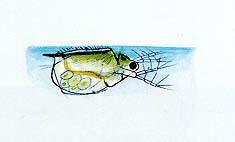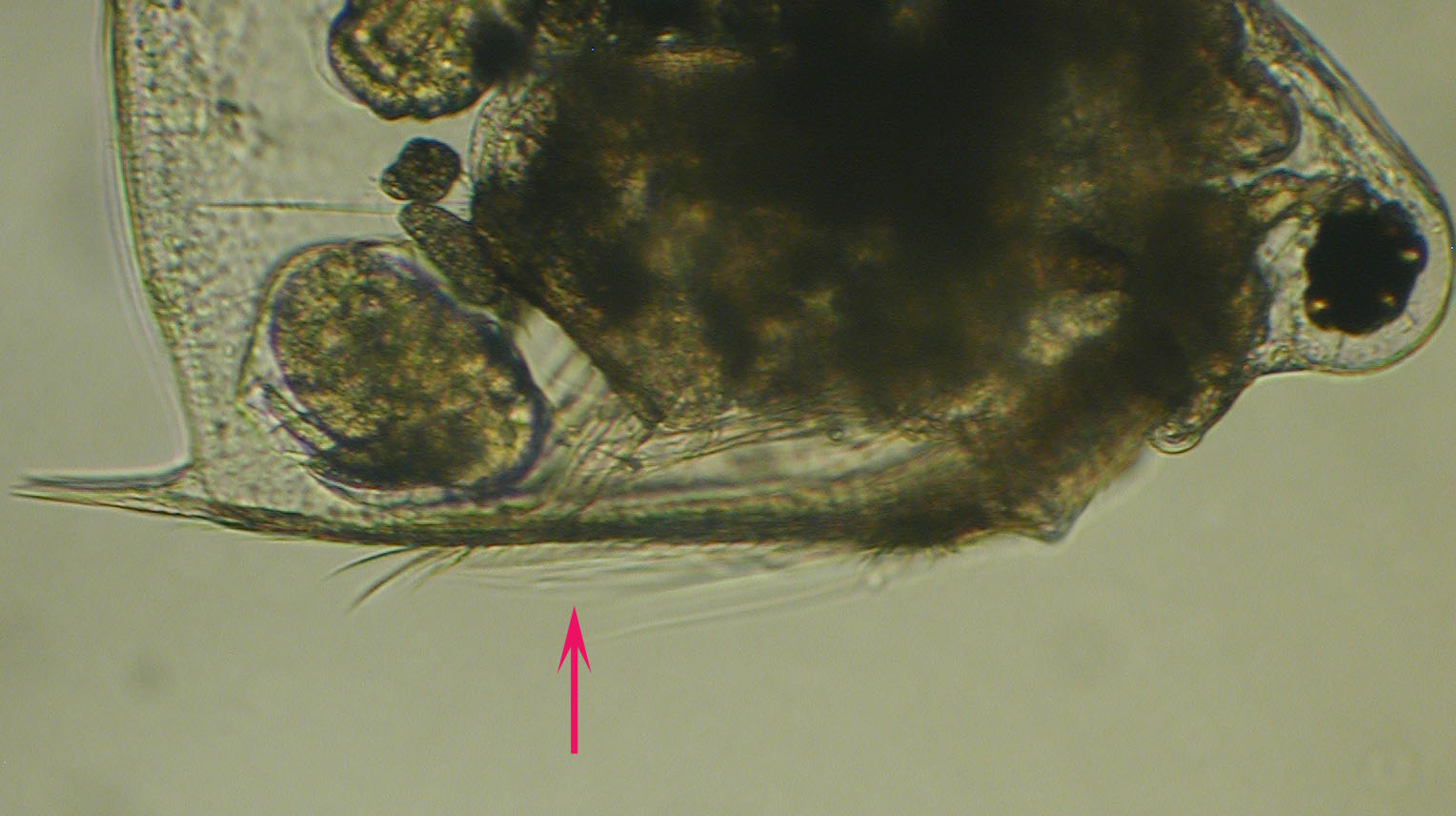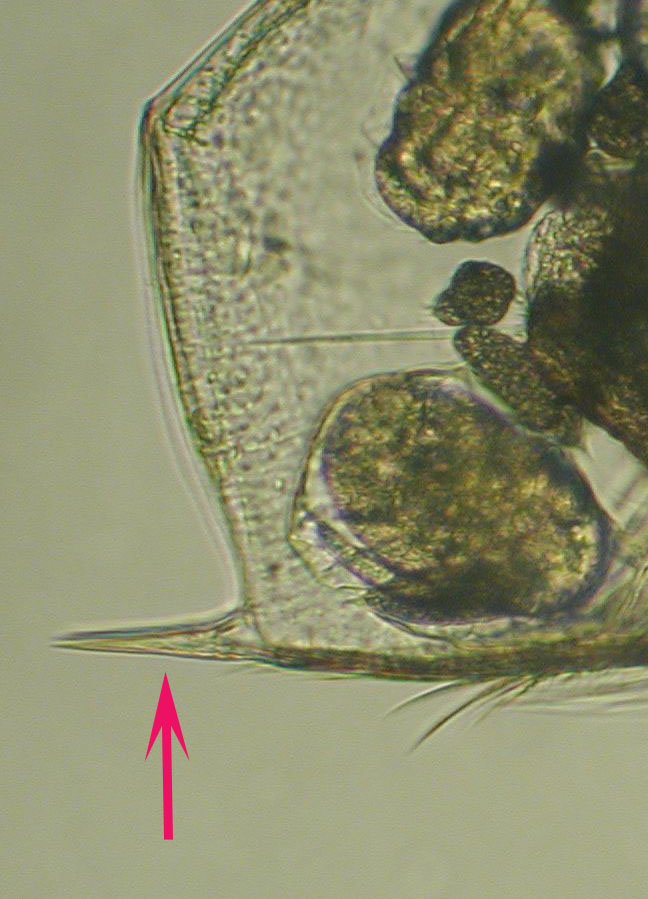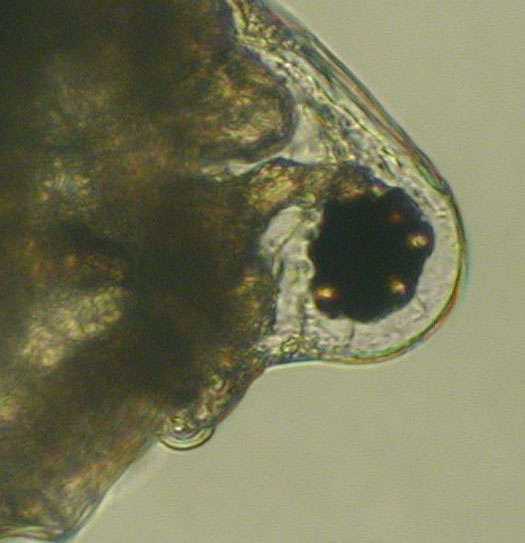|
Classification Kingdom - Animalia Taxonomic History The first description of the genus can be attributed to O.F. Müller
in 1785. Müller first cited the species as Daphne mucronata, but
the genus name was later changed to Scapholeberis by E. Schoedler
in 1858, which allowed the incorporation of three species:
mucronata, cornuta n.sp., and obtusa. Currently, the
genus Scapholeberis contains seven described species plus one
subspecies (Dumont and Pensaert 1983). Anatomy Scapholeberis mucronata is a cladoceran ranging from 0.5 to 1.2 mm for females and 0.4 to 0.7 mm for males. Its large head has a prominent compound eye, which can be slightly larger in males. S. mucronata also has a well-developed, rectilinear rostrum (Dumont and Pensaert 1983). A developed head spine may also be present, depending on seasonal conditions (Green 1963). The most interesting feature of S. mucronata is the modified carapace. The ventral rim is folded inwards to form a sucker-plate, with the posterior corner demonstrating a mucro. S. mucronata uses this sucker-plate to hang upside down on the hyponeuston of the water surface (Dumont and Pensaert 1983). The ventral rim and head of S. mucronata is highly pigmented with melanin, which may protect against photodamage and predation (Dodson and Frey 1991). Distribution The subfamily Scapholeberinae can be found worldwide in temperate and boreal environments of the northern hemisphere. S. mucronata is prevelant in Palaearctic and North Holarctic areas, specifically in Central Asia, Alaska, and Central Europe. S. mucronata has often been linked to the distribution and morphology of Scapholeberis kingi. While many researchers still debate the true range and identification of S. kingi, Dumont and Pensaert (1983) limit the accurate distribution of S. kingi to Australia, Africa, Middle East, and South-East Asia regions. Habitat S. mucronata can typically be found during the summer months in weedy littoral areas (Dumont and Pensaert 1983). During the day, the species is highly aggregated in the littoral areas, but this preference becomes somewhat weaker at night. The phototactic response of S. mucronata could influence a lower degree of habitat selection during the night (De Meester et al 1993). The hyponeustonic behavior of S. mucronata can make it vulnerable to wind-driven movement, so the species is most often found in lakes, ponds, and slow flowing rivers protected from wind (De Meester et al 1993; Dumont and Pensaert 1983; Green 1963). Feeding The neustonic region contains a surface film formed by bacteria that includes near-surface concentrations of phytoplankton and allochthonous nutrients (Thorp and Covich 1991). S. mucronata is the only cladoceran to exhibit neustonic feeding by hanging upside down. S. mucronata will glide forward, and through filtration of the surface film, it will feed on phytoplankton and the available organic material (Olsen et al 2001). Life History Populations of S. mucronata reproduce by cyclic parthenogenesis. During the early spring, females have their maximum production parthenogenetic eggs. Populations are made up of mostly females until sexual reproduction requires the production of males. There are usually two waves of sexual reproduction during the year. In early summer, there is a very short period of sexual reproduction, while a longer period lasts from late summer into fall. A noticeable increase in males and ephippial females can be detected during this late summer period (Green 1963). Ephippium of Scapholeberis spp. typically contains a single egg (Dumont and Pensaert 1983). When compared to coexisting Cladoceran species, the reproductive production of Scapholeberis mucronata allows for a reproductive advantage through various temperatures (Lemke and Benke 2003).
|
Scapholeberis mucronata 
Figure 1. Scapholeberis mucronata has a large head with conspcious eye and rectilinear rostrum
Figure 2. Scapholeberis mucronata female with folded ventral margin of carapace. a
Figure 3a. Posterior mucro of Scapholeberis mucronata Figure 3b. Anterior view of Scapholeberis mucronata female  Figure 3. Neustonic feeding behavior of Scapholeberis mucronata (Olsen et al 2001) |
Works Cited De Meester, L., S. Maas, K. Dierckens, and H.J. Dumont. 1993. Habitat selection and patchiness in Scapholeberis: horizontal distribution and migration of S. mucronata in a small pond. J. Plank. Research 15(10): 1129-1139. Dodson, S. and D. Frey. 1991. Cladocera and other Branchiopoda. In: Thorp, J.H. and A.P. Covich, eds. Ecology and Classification of North American Freshwater Invertebrates. Harcourt Brace Jovanovich, N.Y.: 723-786. Dumont, H.J. and J. Pensaert. 1983. A revision of the Scapholeberinae (Crustacea: Cladocera). Hydrobiologia 100: 3-45. Green, J. 1963. Seasonal polymorphism in Scaphroleberis mucronata (O.F. Müller) (Crustacea: Cladocera). J. Anim. Ecol. 32(3): 425-439. Lemke, A.M. and A.C. Benke. 2003. Growth and reproduction of three Cladoceran species from a small wetland in the south-eastern U.S.A. Freshwater Bio. 48:589-603. Olsen, L.-H., J. Sunesen, and B.V. Pedersen. 2001. Small Freshwater Creatures. Oxford University, N.Y. Thorp, J.H. and A.P. Covich. 1991. An overview of freshwater habitats. In: Thorp, J.H. and A.P. Covich, eds. Ecology and Classification of North American Freshwater Invertebrates. Harcourt Brace Jovanovich, N.Y.: 17-36. |


 b
b 